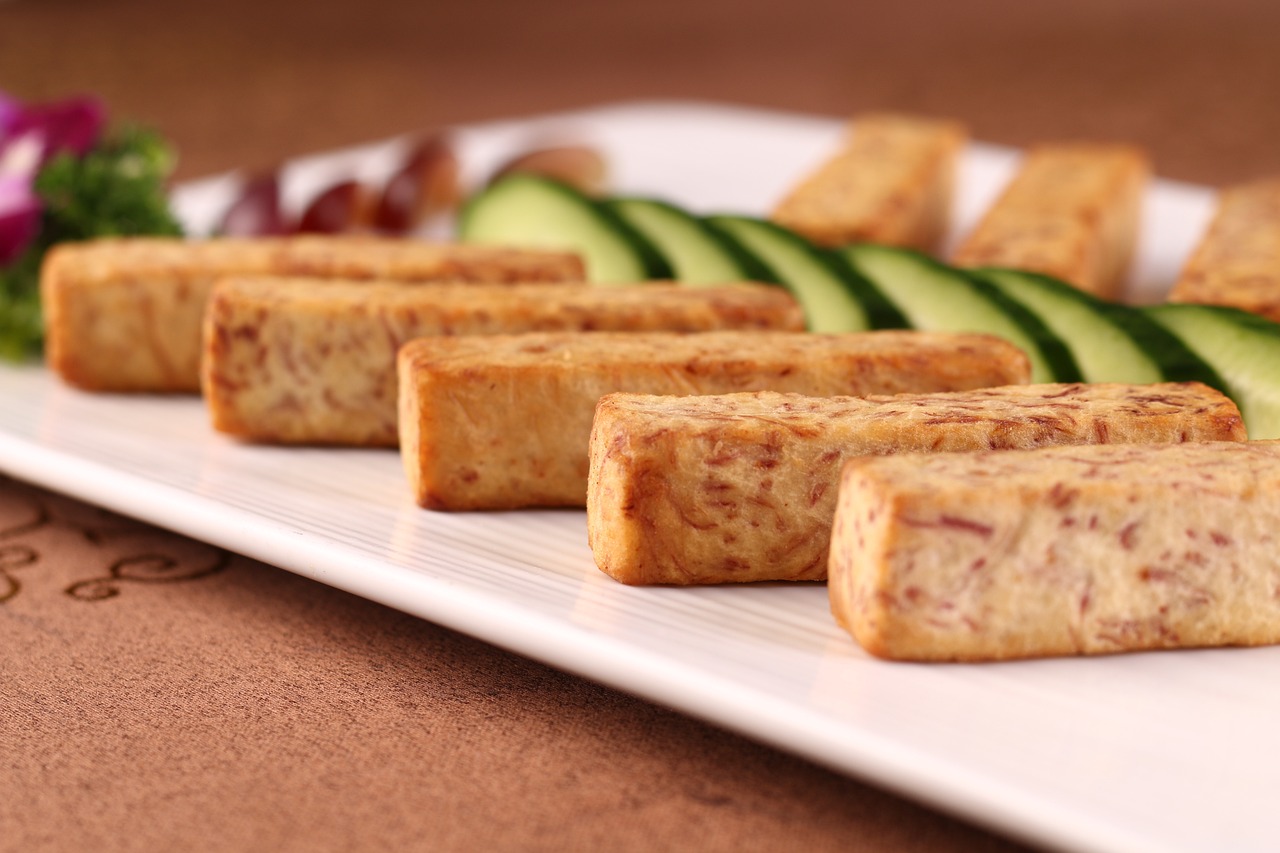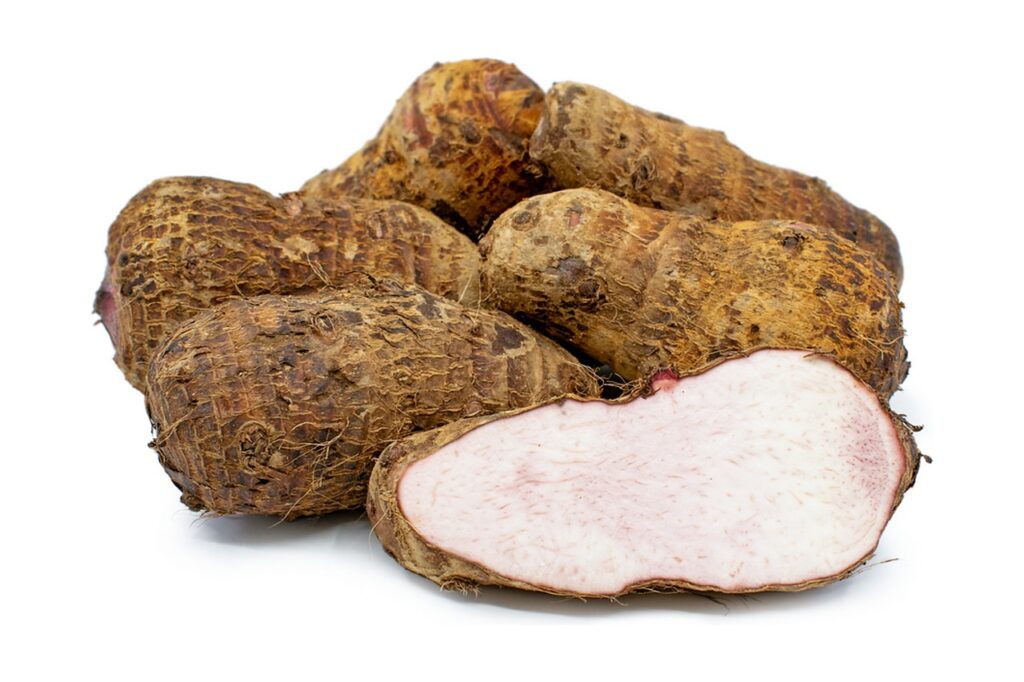Taro vs Ube? Introduction
Taro and ube are two root vegetables that have gained immense popularity in the culinary world. Both of these vegetables are used in various dishes that are appreciated for their unique flavors and vibrant colors. Although taro and ube share some similarities in terms of appearance and texture, they are two distinct vegetables that offer different taste profiles. This article will explore the differences between taro and ube and provide a comparison of their taste, flavor, and appearance.
The Popularity Of Taro And Ube In Different Cultures
While taro is commonly used in Polynesian, Hawaiian, and Caribbean cuisines, ube is more commonly found in Filipino desserts and pastries. In recent years, however, ube has gained immense popularity worldwide due to the rise of social media. Many food bloggers and influencers have shared pictures of ube-based dishes, which has led to the increased popularity and recognition of this root vegetable.
Taro, on the other hand, is a staple ingredient in many Pacific Islander dishes. It is a common filling for poi, a Hawaiian dish made by mashing taro root and mixing it with water. Taro is widely used in savory meals as well, such as taro chips and taro bubble tea.
Overview Of The Differences Between Taro And Ube
Taro and ube are both root vegetables with unique taste and flavor profiles. Taro, scientifically known as Colocasia esculenta, offers a mild and nutty flavor. It has a starchy texture, somewhat like a potato, and tastes like a mix of sweet potato and chestnut. Ube has a vibrant royal purple hue, along with a slightly sweet and earthy flavor. The taste of ube is often compared to that of vanilla or white chocolate.
In terms of appearance, taro has a light-colored inside speckled with dots, while ube has a deep purple color. Ube is also much sweeter than taro and is often used as a primary ingredient in desserts, from cakes, ice creams to pastries.


In conclusion, while taro and ube share some similarities, they are two unique root vegetables that offer different taste, texture, and flavor profiles. Each of these vegetables plays a significant role in the culinary world and is widely used in various traditional and modern dishes.
Taro: What You Need To Know
What Is Taro?
Taro is a starchy root vegetable that is commonly found in Pacific Islander, Hawaiian, and Caribbean cuisines. It is scientifically known as Colocasia esculenta and is used as a staple ingredient in many dishes.
Taro’s Physical Appearance And Common Uses
Taro has a primarily brownish bark but looks distinctly different from the inside. It has a light-colored inside speckled with dots and has a starchy texture, similar to that of a potato. Taro’s flavor is mild and nutty, with a taste like a combination of sweet potato and chestnut.
Taro is widely used in savory dishes, such as chips and bubble tea, as well as traditional Hawaiian dishes like poi, which involves mashing the taro root and mixing it with water. Poi is commonly eaten as a nutritious and filling side dish.
Taro is also a versatile ingredient in both traditional and modern cooking, and it is commonly used in cakes, bread, and puddings. Its distinct flavor and texture can add a unique taste to any dish.


In conclusion, taro is a unique and versatile root vegetable with a mild, nutty flavor and starchy texture. It is a staple ingredient in many Pacific Islander dishes and is commonly used in both savory and sweet dishes. Taro’s distinct taste and texture make it a valuable ingredient in the culinary world.
Ube: What You Need To Know
What Is Ube?
Ube is a Southeast Asian yam scientifically known as Dioscorea alata. It is a root vegetable that has a vibrant royal purple color inside and has a flavor that is nutty with a vanilla-like taste. Ube is often confused with taro, another similar root vegetable, but the two are distinct. Ube is mainly used in sweet dishes, but it can also be cooked with savory spices.
Ube’s Physical Appearance And Common Uses
Ube and taro have similarities in that they are both tubers with bark-like skin and pink-hued flesh. However, the difference between the two root vegetables is apparent once you cut them open. Ube has a bright purple inside, while taro has a lightly-colored inside speckled with dots.
Ube has become a popular ingredient in desserts, especially in Filipino cuisine, with the emergence of social media. It can be added to cakes, pastries, ice cream, and even coffee drinks, providing a unique purple hue and a nutty flavor to these sweet treats.
Ube can also be used in savory dishes like rice meals and stews. It can be boiled, mashed or used as an alternative to sweet potatoes or pumpkins in recipes.


In conclusion, Ube is a versatile and unique root vegetable that has gained popularity in recent years, thanks to its distinct flavor, color, and texture. Its flexibility in both sweet and savory dishes, coupled with its health benefits, make it a valuable ingredient in the culinary world.
Nutritional Value
Taro’s Nutritional Benefits
Taro is a starchy root vegetable that is a popular choice for savory dishes. It is a rich source of fiber, vitamins C and E, and potassium. Taro is also low in fat and sodium, making it a great choice for a healthy diet. Its high fiber content helps maintain regular bowel movements, while its vitamin C and E content support a healthy immune system and healthy skin.
Ube’s Nutritional Benefits
Ube, on the other hand, is a highly nutritious root vegetable that is used mainly in sweet dishes, particularly in Filipino cuisine. Like taro, it is rich in vitamins A, B types, and C, as well as antioxidants such as potassium and magnesium. Ube is also high in fiber, which aids in digestion and promotes good gut health.
Both taro and ube are excellent sources of nutrients and are highly recommended for inclusion in a healthy diet. Ultimately, it comes down to personal preference and what flavor profile one enjoys more.
Culinary Uses
Taro’s Culinary Uses
Taro is a versatile root vegetable that can be prepared and used in many ways. It is often used in savory dishes, such as stews, curries, and soups. Taro can also be mashed, fried, or roasted as a side dish or snack. In Hawaii, taro is used to make poi, a popular staple food made by mashing cooked taro with water. Additionally, taro leaves are used in various savory dishes. Despite its starchy texture, taro can be used in sweet preparations, such as in cakes and desserts.
Ube’s Culinary Uses
Ube is most commonly used in sweet dishes and is known for its unique flavor and vibrant purple hue. It is often used in desserts such as cakes, ice cream, puddings, and pastries. Ube can also be boiled, mashed, or steamed, and used in savory dishes, particularly in Filipino cuisine. In the form of halaya, a sweet dish made with mashed ube and sweetened condensed milk, it is commonly used as a topping or filling for bread and pastries. Additionally, ube can be used as a natural food coloring in dishes such as rice and noodles to add a pop of purple color. Its sweet and nutty taste pairs well with coconut, cheese, and other complementary flavors.
In conclusion, both taro and ube are versatile root vegetables that can be used in a wide variety of dishes. Whether used in savory or sweet preparations or incorporated into traditional or modern cuisine, these two ingredients offer unique flavor profiles and a wealth of nutritional benefits. Understanding their culinary uses and cultural significance can enhance one’s appreciation of these versatile produce items.
Availability And Cultivation
Where Is Taro Grown?
Taro is cultivated in many parts of the world, particularly in tropical and subtropical regions. It is commonly grown in Asia, Africa, the Pacific Islands, and South America. In the United States, taro is primarily grown in Hawaii, where it holds cultural significance and is a popular ingredient in traditional Hawaiian cuisine.


Where Is Ube Grown?
Ube is primarily grown in Southeast Asia, particularly in the Philippines where it is a popular ingredient in traditional dishes and desserts. It is also cultivated in other parts of the world, such as Hawaii, where it is known as purple yam and used in local cuisine.
When cultivating taro and ube plants, it is important to pay attention to their growing conditions and cultivation practices. Both plants thrive in tropical or subtropical climates and require well-draining soil and consistent moisture. They can be grown in flooded fields or backyard gardens, depending on the scale of cultivation. Propagation can be done through planting stem cuttings or corms, which are underground storage organs.
In conclusion, taro and ube plants offer a range of culinary and medicinal uses and are grown in many parts of the world. Understanding their growing conditions and propagation methods can ensure successful cultivation and production of healthy crops. Whether used in savory or sweet preparations, these two root vegetables offer unique flavors and nutritional benefits.
Similarities Between Taro And Ube
Similarities In Taste And Texture
While taro and ube have distinct differences in appearance, they share some similarities in terms of taste and texture. Both have a slightly sweet and nutty flavor, which makes them suitable for various culinary creations. In terms of texture, they are starchy and similar to potatoes or sweet potatoes. This texture makes them suitable for use in both savory and sweet dishes.
Health Benefits
Both taro and ube offer essential health benefits. They are rich in fiber, vitamins, and minerals that aid in digestion and maintain overall health. Taro is loaded with potassium, which is essential for regulating blood pressure and heart health. On the other hand, ube is rich in antioxidants that help reduce the risk of chronic diseases such as cancer and diabetes.


Despite sharing some similarities, taro and ube also offer distinct differences in terms of texture, color, and nutritional value. Understanding these differences can help you choose between the two ingredients while planning your next dish. So whether you prefer the light speckled texture of taro or the vibrant purple hue of ube, both root vegetables offer a range of culinary and medicinal benefits that make them excellent additions to any diet.
Differences Between Taro And Ube
Color And Appearance
Taro and ube are two tuber vegetables that look quite similar from their outer appearance. Both have a brownish bark and grow in tropical regions. However, their major distinction lies in the inner flesh. Ube, also known as purple yam, is characterized by a bright, vibrant, royal purple color. Taros have a light-colored interior speckled with dots and is usually white with a few pink freckles.
Taste And Flavor
Aside from appearance, taro and ube also differ in terms of taste and flavor. Taro has a mild earthy flavor, similar to that of a potato, combined with a slightly sweet nutty flavor. Ube, on the other hand, has a nuttier and sweeter taste with a hint of vanilla flavor. Taro is used in savory dishes, such as soups and stews, while ube is used in sweet dishes, such as cakes and pastries.
In terms of nutritional value, both root vegetables provide health benefits to the body. Taro is an excellent source of dietary fiber, vitamins, and minerals that aid in digestion and promote overall health. It is also high in potassium, which helps regulate blood pressure and improve heart health. Ube, on the other hand, has antioxidants that protect the body from chronic diseases such as cancer and diabetes.
In conclusion, the difference between taro and ube may seem subtle at first glance, but it lies in their color, taste, and nutritional value. Understanding these distinctions can help you choose the appropriate ingredient for your dish. Whether you prefer the light speckled texture of taro or the vibrant purple hue of ube, both root vegetables provide a range of culinary and medicinal benefits that make them great additions to any diet.
Choosing Taro Or Ube
When it comes to deciding between taro and ube, there are several distinctions that can influence your decision.
Health Considerations
Both taro and ube offer unique nutritional benefits to the body. Taro is an excellent source of dietary fiber, vitamins, and minerals that aid in digestion and promote overall health. It is also high in potassium, which helps regulate blood pressure and improve heart health. Ube, on the other hand, has antioxidants that protect the body from chronic diseases such as cancer and diabetes.
Depending on your health needs, you may want to choose one root vegetable over the other. For example, if you’re looking to increase your potassium intake, taro would be a better choice. On the other hand, if you’re concerned about chronic diseases, ube may be the better option.
Culinary Considerations
Taro and ube not only differ in their nutritional value but also in their culinary applications. Taro has a mild earthy flavor, similar to that of a potato, combined with a slightly sweet nutty flavor. It is commonly used in savory dishes, such as soups and stews. Ube, on the other hand, has a nuttier and sweeter taste with a hint of vanilla flavor. It is typically used in sweet dishes, such as cakes and pastries.
Your choice between taro and ube will depend on the dish you’re planning to make. If you’re making a savory dish, such as a soup or stir-fry, taro may be the better choice. If you’re making desserts or other sweet dishes, such as pancakes or ice cream, ube may be more appropriate.
In summary, when choosing between taro and ube, it’s crucial to consider their distinctions in terms of health benefits and culinary use. Understanding these differences can help you make an informed decision and choose the right root vegetable for your dish.
Choosing Taro Or Ube
When it comes to choosing between taro and ube, there are several factors to consider. One of the main distinctions is their nutritional value. Taro is a great source of dietary fiber, vitamins, and minerals that promote overall health and aid in digestion. It is also high in potassium, which helps regulate blood pressure and improve heart health. On the other hand, ube has antioxidants that can protect your body from chronic diseases such as cancer and diabetes.
Aside from their nutritional content, taro and ube also differ in their culinary applications. Taro has a mild earthy flavor with a nutty sweetness, making it a great ingredient for savory dishes such as soups and stews. In contrast, ube has a nuttier and sweeter taste with hints of vanilla, making it perfect for sweet dishes such as cakes and pastries.
Ultimately, the choice between taro and ube will depend on the dish you intend to make. If you plan to make a soup or stir-fry, taro may be the better option, while ube may be more appropriate for desserts such as ice cream or pancakes.
Final Thoughts On Taro Vs. Ube
Taro and ube are both versatile root vegetables that offer unique flavors and culinary uses. Taro has a mild and nutty taste with subtle sweetness and earthy undertones, while ube has a nuttier and sweeter taste with a hint of vanilla. Both vegetables are great for unique dishes and can be used in a variety of ways to enhance their flavors.
Which One Is Better For You?
Choosing between taro and ube depends on your personal preference and needs. If you’re looking for a nutrient-dense option that can improve digestive and heart health, taro may be the better option. On the other hand, if you’re concerned about chronic diseases, ube has beneficial antioxidants. Ultimately, both vegetables can be healthy and delicious additions to your meals, so it’s worth experimenting with both to determine which one you prefer.
Q: What is the difference between Taro and Ube?
A: Although they may look similar on the outside, Taro and Ube have distinct differences on the inside. Ube has a vibrant royal purple hue, while Taro has a light-colored inside speckled with dots.
Q: Are Taro and Ube the same thing?
A: No, Taro and Ube are not the same thing. They are two different root vegetables that are often mixed up because of their similarities in appearance.
Q: Which one is more starchy, Taro or Ube?
A: Taro is generally more starchy than Ube when cooked.
Q: Can Taro and Ube be used interchangeably in cooking?
A: They may be similar in texture and appearance when cooked, but they have distinct flavor profiles. It is best to use them according to the recipe’s specific requirements.
Q: How do I identify Taro and Ube in the grocery store?
A: Taro has a rough, hairy exterior that is light brown or beige in color. Ube, on the other hand, has a smooth, dark purple exterior. Always check the labels or ask the store staff if you are unsure.
Q: Are Taro and Ube both nutritious?
A: Yes, both Taro and Ube are nutritious root vegetables. They are rich in fiber, vitamins, and minerals. However, their nutritional content may vary depending on the type and cooking method used.
Q: What are some dishes that can be made with Taro and Ube?
A: Taro and Ube can be cooked in a variety of ways, such as baked, boiled, mashed, or fried. Some popular dishes that use these root vegetables include Taro chips, Ube Halaya (jam), Taro or Ube ice cream, and Taro or Ube bread.



Hey there! If you’re a fan of authentic Mexican cuisine, you’re in for a treat with Humberto Cruz at pointcafeny.com. They take immense pride in serving their customers with home-cooked, genuine Mexican dishes crafted with the finest ingredients. From flavorful salsa to mouthwatering tamales and enchiladas, they offer an experience that brings the taste of family food from back home right to your table. Don’t forget to check out their tempting Daily Specials for a delightful culinary adventure!
